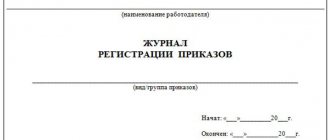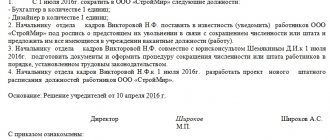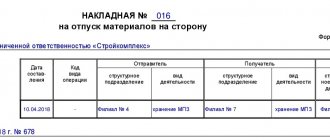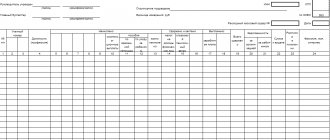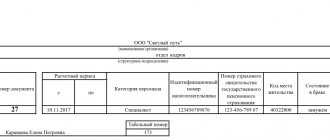Author: Ivan Ivanov
In every company, regardless of its size, activity, income and other indicators, official documents are drawn up with the signature of the head and the seal of the organization.
When implementing document flow, one of the important actions is document numbering. It is not carried out in all cases.
Documentation is subject to numbering for ordering. A legal entity has the right to independently establish its own document flow system, as well as its numbering order.
What is it: concept and essence
Numbering represents the assignment of a serial number to a document.
The number is assigned on the day of signing outgoing correspondence and on the day of receiving incoming correspondence.
Attribution is a sign that it has legal force. The process of numbering means its registration in the general document flow system of the enterprise. It is no longer possible to remove or get rid of such a document.
Numbering serves the main purposes:
- systematization of documents at the enterprise;
- convenient search;
- implementation of control actions over signed documentation.
Accounting for personnel orders, their numbering and method of registration
A personnel order acquires legal force from the date of its signing by the manager and the executor, after which the document specialist registers it in the journal of accounting and registration of orders and files it in a folder along with other orders of similar importance.
Despite the fact that a journal for registering documents is not a mandatory record , many personnel workers still prefer to create them because of their ease of use.
The registration number is indicated in ascending order, and is indexed in accordance with the nature of the contents in the order (for example, “ok” or “to” - personnel document, “pr” - production document, “from” - leave, “hp” - personnel and etc.).
different for registering orders . They are made to order, or sold in any specialized stationery store, with the appropriate name, columns, already adjusted to specific purposes.
Which one exists?
Numbering can be incoming and outgoing for documentation received from a third party or outside the organization, respectively.
Numbering can be automatic or manual. As a rule, the second method of assigning a number is used, since it must be assigned after the document is signed by the responsible person. When assigned automatically, the working program sets it at the time of compilation before signing.
The number itself (index) can be numeric, alphanumeric, or mixed with signs. A numeric code can be used separately (for example, No. 156), alphabetic and symbolic together with a numeric one (for example, 12-11/158 or 12-k, etc.). Letters are most often used in personnel documents and are a designation of one type or another, for example, an order for employment - “p”, for a business trip - “k”, etc.
In some cases, to avoid duplication, numerical boundaries are established. For example, No. 1 - 100 - orders for admission, No. 101 - 200 - orders for dismissal.
Forms and types of orders for personnel
There are many types of orders for personnel. Let us list their enlarged groups:
- Organizational: on hiring, dismissal, relocation of employees, etc.
- Disciplinary: about punishment or reward.
- Routine: about sending on a business trip, various vacations.
- Salary: on the establishment of salaries, allowances and additional payments.
- Incentive: about bonuses and other rewards.
- Of a technical nature: canceling - if necessary, cancel a previously issued order or its individual paragraphs, amending - introducing amendments and adjustments to existing orders.
All of these groups of orders have a common feature - the concept of “personnel”. This is the entirety of the company's employees. As a result of the issuance of any order regarding personnel, any member of the workforce or all employees of the company experience one or another result.
Orders for personnel are designed to solve a whole range of problems:
- regulation of labor relations “employee - employer”;
- formation of an optimal structure and number of personnel;
- resolving issues of compliance with guarantees in relation to members of the labor collective;
- operational influence on resolving issues of current economic activity through the optimal deployment of personnel;
- strengthening labor discipline in the team;
- other tasks.
You can develop the order form yourself, providing it with all the necessary details:
- Company name;
- order number;
- date;
- content;
- base (if necessary);
- signatures of the manager and employees.
You can download a sample review sheet for personnel orders from ConsultantPlus. If you have access to the system, you can access the sample using this link. If you don't have access, get trial access for free and proceed to the sample.
Each type of personnel order pursues its own organizational or operational goals. More on this in the following sections.
How to number and register
The method of document numbering is chosen by the company itself, as specified in local regulations.
If any changes are made, this will be reflected there. However, you can change the numbering method only from the beginning of a new calendar year. Documents on core activities are numbered separately from personnel documentation. Numbering can be done either automatically in the working program (usually 1C) or manually.
For correct assignment, a log book (registration book) is used. It reflects the date, number, content and information about the persons who compiled and signed the order.
If the company’s document flow is large, then, in addition to numbers, it also contains alphabetic characters. Most often, letter designations are used for documents with different shelf life.
Registration can be done by entering the number, date and name in the registration log or the main characteristics in the electronic document management system.
The company itself chooses its preferred registration method. In some cases, both types are used. This is not a mandatory procedure, but is carried out for the purpose of safety and reliability.
The registration log is compiled on paper and presents a table with column names. The form of such a journal, as well as the content, is determined by the legal entity.
Numbering is done depending on the types of orders in the company. Thus, the following types of activities are distinguished:
- main;
- by personnel;
- administrative and economic.
Depending on the variety, the place in the company’s document management system, numbering, and storage period are determined.
By main activity
These include orders:
- on the creation of a company;
- on approval of the staff schedule;
- on approval of the vacation or business trip schedule;
- on the creation of separate structural divisions of the organization;
- on mergers with other enterprises;
- on reorganization or liquidation;
- others regarding the company's activities.
Orders are usually divided depending on the storage period for assigning registration numbers.
Orders regarding the main activity have a registration number consisting of numbers and symbols, or only numbers. Letter designations are mainly used for numbering personnel orders.
Personnel
These orders include all document flow regarding the employees of the enterprise. The varieties are as follows:
- about hiring for a position;
- about the transfer of an employee;
- on employee bonuses;
- about promotion;
- about dismissal;
- about disciplinary action;
- about a business trip;
- about training, etc.
In other words, all actions in relation to the company’s employees are reinforced by orders that relate to personnel records management.
How to correctly number orders for personnel and main activities
Glafira (guest) #10[35577] February 18, 2009, 17:33 Irina wrote: I've been looking for so much, can you send me the link? please... Irina, at the top of the forum there is a “search” window, enter the word “order” into it, press the OK button (next to the right) and in front of you is a whole encyclopedia about ordering. I want to draw the moderator’s attention to this message, because: A notification is being sent... Ksyushechka As I understand it? Is this how it should be? We are in complete chaos with this, I already wrote about it. I have the following orders registered: 1. According to the fire department without-ti2. On the creation of all kinds of commissions, including certification3. Business trips4. Bonuses, incl. deprivation, financial assistance, encouragement, allowances, etc.5. Orders on transport (registration, maintenance, fuel consumption standards, etc.)6. Staffing table, incl. approval, modification, modification of work schedules7. On approval of instructions, regulations, etc.8.
- Themes:
- HR records management
- Orders
- Nomenclature of cases
Is new numbering of personnel orders mandatory from the new year? Which ones exactly? From the article you will learn:
- how orders are numbered for personnel;
- how personnel orders are numbered;
- how to number orders for core activities.
Nomenclature of cases Download in .doc Numbering of orders An order is an internal administrative document of an organization. In each organization, the process of activity requires the adoption and documentation of certain rules.
The manager signs all orders of the organization.
How to number orders in personnel records
What does it mean to assign a number to an order? To assign a number to an order means:
- streamline the process of registering personnel documentation;
- speed up the procedure for recognizing an order if necessary, find it in the total volume of personnel papers;
- facilitate the classification of orders when processing documents for storage.
The specifics of numbering orders in personnel records are as follows:
- the need to distinguish between documents with long-term (75 or 50 years) and short-term (from 1 to 5 years) storage periods;
IMPORTANT! The Law “On Amendments to the Federal Law “On Archiving in the Russian Federation” dated March 2, 2016 No. 43-FZ, from March 2020, introduced shortened storage periods for documents on personnel - 50 years, except for those created before 2003 ( for them the term is still 75 years).
Correct numbering of orders in personnel records management
Transport services, internal communications;4. Security. I want to draw the moderator's attention to this message because: A notification is being sent...
I am at the best age: there is no more stupidity, there is STILL no insanity... My head is a mess, but everything is scattered and lies somehow according to Feng Shui... I want to draw the moderator’s attention to this message, because: A notification is being sent... Attention Vikulya [e- mail hidden] Russian Federation, Moscow #5[35497] February 18, 2009, 14:37 Linas, thank you very much! I want to draw the moderator’s attention to this message because: A notification is being sent... All things in the strange human world are changeable. Soft, purring cats are constant. I want to draw the moderator's attention to this message, because: A notification is being sent... Irina (guest) If we number as necessary, i.e.
Numbering of orders in personnel records management
On approval of unified forms of primary accounting documentation for accounting of labor and its payment" download Rules of maintenance Example of a dismissal order The registration number of the order consists of its serial number and index. The indexation of the order is determined by the individual nomenclature of cases and the rules for registering orders at the enterprise.
Important Despite the fact that each organization prescribes its own numbering order for administrative documents, there is a certain number of general rules that firms try to adhere to. Namely: In companies with a small document flow, there is no need to separate orders into numerous types. But they cannot be combined due to different storage periods for documents.
This type of orders is divided into 2 groups:
- The retention period is 75 years for orders that form labor relations and significant changes in the lives of employees. (Hiring, dismissal, change of name);
- The shelf life is 5 years for short-term orders. (Vacation, business trip, reprimand).
By main activity:
- General orders throughout the enterprise;
- By department;
- For administrative and economic activities;
On a note! When preparing orders, use unified documents approved by Decree of the State Statistics Committee of Russia dated January 5, 2004 No. 1. It is acceptable to issue orders in any form, since unified forms do not cover the entire range of personnel operations. Administrative documents without an approved form are drawn up in text form on the official letterhead of the organization.
How are orders for main activities numbered?
A bank’s refusal to carry out a transaction can be appealed. The Bank of Russia has developed requirements for an application that a bank client (organization, individual entrepreneur, individual) can send to an interdepartmental commission in the event that the bank refuses to make a payment or enter into a bank account (deposit) agreement. → Accounting consultations → Personnel documents Updated: October 19, 2020 Personnel documentation is a comprehensive set of orders, forms, statements and other documents.
How are orders numbered for core activities?
Therefore, it can be recommended that an organization establish rules for working with certain types of organizational and administrative documents in local regulations, for example, in the Instructions for Office Work or in the relevant Standard that defines work with a specific type of organizational and administrative document. But the development of internal local regulations should be based on the rules defined by the above-mentioned regulations, even despite their advisory nature.
Here are excerpts from these documents: State standard of the Russian Federation GOST R 6.30–2003 “Unified documentation systems. Unified system of organizational and administrative documentation.
Requirements for document preparation" "3.12.
Numbering of orders for personnel and main activities
Limited Liability Company "AST" INN/KPP 7804491337/780401001 195198, St. Petersburg, Lenina Ave., 21, building 1, room. 309 ORDER No. 1
St. Petersburg 01/01/2016 I ORDER:
- Introduce, starting from 2020, alphanumeric indexing of administrative documents for the personnel of AST LLC using the following registration letter indices: orders for hiring an employee - P (reception); 2. orders to terminate the employment agreement (contract) with an employee - U (dismissal);3. orders to transfer an employee to another job - PR (transfer of an employee);4. orders for granting leave to an employee - O (vacation);5. orders on violation of labor and production discipline - N;6. the remaining orders are K (cadres).
- Control over the implementation of this order is assigned to the Financial Director Oleg Dmitrievich Ivanov.
General Director A.S.
Examples of indexes include:
- “ls” - orders for personnel;
- “p” - about hiring;
- “y” - about termination of the employment contract;
- “k” - about the appointment of a business trip, etc.
Orders relating to the main activities of an enterprise are usually numbered using only numbers, indexes are not used, however, an organization can also use a letter code, and no one can prohibit it from doing so. Numbers are assigned to orders in chronological order, starting with number 1.
Every year the numbering starts from the beginning. The exception is educational and cultural institutions - in them the beginning of the year for office work purposes is September 1.
This numbering simplifies the solution of issues related to searching and storing orders. This means that as long as the organization carries out activities, it is obliged to preserve documents, including orders for its main activities.
Orders for personnel also have a rather long, but still limited shelf life.
In this case, the period during which the organization is obliged to ensure the safety of documents will be determined depending on the date of creation of the document. So, if the date of creation of the document falls before 2003, orders must be stored for 75 years.
If paperwork for a document was completed after January 1, 2003, the storage period is limited to 50 years. The storage periods for documents on personnel were adjusted in 2020 by introducing Article 22.1 of the Federal Law of October 22, 2004 N 125-FZ “On Archival Affairs in the Russian Federation.”
Source: https://law-uradres.ru/kak-pravilno-numerovat-prikazy-po-kadram-i-osnovnoj-deyatelnosti/
Examples and samples
Below are examples of documents containing the number.
This order consists of numbers and symbols. The numbers “02” indicate the department number separated by a fraction. the number “17” is the serial number from the beginning of the year.
The next one consists of numbers, signs and letters. Where, the number “15” is a sequential number, and through the fraction the letter designation “OD” is the main type of activity.
And finally, the third, the index of which consists exclusively of the numbers “12”.
As stated above, all documentation is recorded and reflected in the log book. The journal for recording orders for the main activity includes the order number, its date, brief content, information about the responsible person and the originator, as well as the deadline for notes.
The log also indicates the beginning of filling and its end. Upon completion, the stamp and signature of the person responsible for filling out is affixed. Then it is filed with the previous ones. As a rule, it is compiled and used throughout the calendar year.
Numbering of orders in personnel records management in 2020
Personnel records management involves the publication and storage of a large amount of documentation. For convenient orientation, it uses special numbering. Its main principles will be discussed in our article.
Why is order numbering needed in personnel records?
During the daily work of a HR specialist, a large amount of documentation arises, both incoming and outgoing. For convenient orientation in a large volume of information, systematization of documents and their numbering are required.
The larger the company, the greater the volume of documents goes through the HR department. Therefore, it will be quite difficult to navigate the documents, paying attention only to the publication date. Numbering allows:
- navigate through a variety of documents;
- establishing relationships between related orders
- systematization in the storage system.
The importance of separation by content is also determined by the difference in shelf life. Orders for personnel must be kept:
- 75 years when published before 2003;
- 50 years when published after 2003.
Whereas vacation orders must be kept for no more than 5 years. Therefore, numbering them together with orders for hiring and dismissal is not justified.
Types of orders
Conventionally, orders can be divided into 3 types:
- by personnel;
- by main activity;
- on administrative and economic activities.
All orders from the HR department belong to the first group. These are orders on employment, dismissal, transfer, vacation, business trip, assignment of duties, etc. However, using a single numbering would be a mistake. As we said above, it is also necessary to rely on shelf life.
Depending on the scale of the company, the last two groups can be either combined into one register for a small enterprise or separated for large volumes. It is also possible to divide orders into subgroups.
Orders on core activities include orders on staffing, material supplies, planning, and financing. The 3rd group includes orders to comply with access control regulations, to comply with PVTR, etc.
Not all of these orders should and can be stored in the personnel department. As a rule, orders for core activities and administrative and economic matters are kept in the office or by the clerk.
How to number orders in an organization
The legislation does not contain any rules on the numbering of personnel orders for hiring and dismissal. Therefore, each company is free to be guided by those principles that are more convenient for its specifics.
Currently, the electronic method of conducting personnel records is widely used. The corresponding program assigns serial numbers independently, just as it maintains their register. If necessary, it is possible to adjust the rules for grouping orders.
In “paper” office work, most often when numbering, a combination of numbers and letters is used, where the number is the serial number of the order, and the letter indicates the category. For example, 2/ls or 2-ls, where 2 is the serial number, and “ls” is the personnel. Orders are indicated using the same principle:
- “p” – employment;
- “u” – dismissal;
- “k” – business trip;
- “o” – vacation, etc.
In a small enterprise, where the personnel document flow is small, within a year it is possible to combine orders into larger groups, for example, for hiring and dismissal.
All issued orders must be registered in the register. For each individual group, its own register is created, which displays the following information:
- serial number;
- publication date;
- content;
- Full name of the employee in respect of whom the document was issued;
- position and structural unit.
People often ask whether there is an order regarding the numbering of orders. All approved principles of document flow in the company must be reflected in the local instructions for personnel records management. It approves the numbering rules, as well as the persons responsible for their publication and storage.
>>> >>>
Numbering of orders every year: new or not
Every year you need to start numbering again. Starting from the new year, either a new register of orders is created, or a corresponding note is made in the existing one about the beginning of the year. And the first document in the new year will always have number 1.
All orders must be created in chronological order; skipping serial numbers or issuing documents retroactively is not allowed. When canceling an order, a corresponding act must be drawn up. This will avoid additional questions from inspection authorities.
Companies often invent fancy numbers that allow them to enter new orders in any number. Although these actions are not entirely legal, with a competent numbering system it will not be easy to guess the trick, because the order of combining letters and numbers is not regulated by law.
The selected numbering system must be reflected in the office management instructions. This will avoid additional questions about the selected system.
Source: https://www.pro-personal.ru/article/1098043-18-m8-numeratsiya-prikazov-v-kadrovom-deloproizvodstve-v-2019-godu
Regulatory regulation
Each organization issues and signs various documents in the course of its activities. The law does not provide for a general document flow system within the enterprise, as well as a numbering procedure.
Only in certain government bodies is such activity regulated by orders of higher departments in relation to specific services. These include: Federal Tax Service, Federal Treasury, Federal Service for Labor and Employment and other government agencies.
Non-state enterprises independently develop rules for document management within their enterprise, which are fixed by order. But these rules should not contradict the Federal Law “On Archiving” dated October 22, 2004 No. 125-FZ, as well as the Decree of the State Standard of the Russian Federation “On the adoption and implementation of the State Standard of the Russian Federation” dated August 3, 2003 No. 65-FZ and the Order of the Ministry of Culture of the Russian Federation “ On approval of the List of standard management archival documents generated in the process of activities of state bodies, local governments and organizations, indicating storage periods" dated 08/25/2010 No. 558.
Thus, the procedure for document management at the enterprise is established by the organization itself and is fixed in official documents. The procedure for assigning a registration number is selected based on the size of the organization and the number of its employees, as well as from the document flow of the enterprise as a whole.
This procedure is necessary both for the convenience of using the documentation of the organization itself, and for monitoring by third-party services.
How to number orders in personnel records
The numbering of orders in personnel records plays a significant role in the functioning of a company, regardless of its size, structure and field of activity.
Personnel records management is a branch of an organization responsible for maintaining documents related to labor relations. Namely:
- Making entries in work books;
- Registration of personal files;
- Creation of orders for personnel;
- Preparation of vacation schedules and staffing;
- Drawing up and transformation of job descriptions;
- Storage and timely submission of documents to the archive;
- Competently making changes to documents;
Types of orders and the need for their registration
Employment order form
Particular attention in the HR document management industry is paid to the creation of orders. Administrative documents are divided into 2 groups:
By personnel. This type of orders is divided into 2 groups:
- The retention period is 75 years for orders that form labor relations and significant changes in the lives of employees. (Hiring, dismissal, change of name);
- The shelf life is 5 years for short-term orders. (Vacation, business trip, reprimand).
By main activity:
- General orders throughout the enterprise;
- By department;
- For administrative and economic activities;
Administrative documents without an approved form are drawn up in text form on the official letterhead of the organization.
In order for orders to have legal force, they must contain the necessary details, signatures of responsible persons and document number.
A well-organized order registration system allows you to:
- Speed up the search for the required document;
- Systematize administrative documents according to their intended purpose;
- Strengthen control over the execution of orders from superiors.
The specifics of using numbering are the following:
- Separation of administrative documents with different storage periods;
- Assigning complex numbers to orders with significant document flow.
Rules of conduct
Example of a dismissal order
The registration number of the order consists of its serial number and index.
The indexation of the order is determined by the individual nomenclature of cases and the rules for registering orders at the enterprise.
Despite the fact that each organization prescribes its own numbering order for administrative documents, there is a certain number of general rules that firms try to adhere to. Namely:
In companies with a small document flow, there is no need to separate orders into numerous types. But they cannot be combined due to different storage periods for documents. In this case, a letter index is added to the order number through a hyphen or slash:
- “personnel” - personnel (Orders for personnel with a shelf life of 75 years);
- “k” - frames (Orders for short-term storage periods).
In organizations with a large staff of employees and administrative documents, a whole system of indexes has been developed for each type of order:
- “p” - hiring;
- “u” - dismissal;
- “pr” - hiring workers;
- “k” - business trips;
- “vk” - internal business trips;
- “zk” - business trips abroad;
- “department” - leave without pay, for pregnancy and childbirth, for child care;
- “otk” - regular vacations, study vacations;
There can be many options for numbering and index designations. Their diversity depends not only on the size of the organization, but also on the specifics of the activities of a particular company.
Every year new or not
It is recommended to number orders with an annual update of the calculation order. From the first working day of the new calendar year, the order will be assigned No. 1. With the exception of cultural and educational institutions, where the office year begins on September 1.
Such a system will help not only organize administrative documents, but also prepare them for further filing in the archive.
Order log
Personnel orders log page
Since the procedure for assigning numbers to orders is not established at the legislative level, personnel officers keep journals for recording orders. The registration process involves copying details from a document and entering this data into a special registration form.
Orders for core activities are maintained at the enterprise separately from orders for personnel. This is due to different areas of activity and shelf life. The numbering of these administrative documents must be kept separately. The order logs will be different.
Labor legislation does not oblige enterprises to keep order logs. Log books are developed by each company independently. But they must contain not only the numbering, but also the date of execution of the document, details, summary and signatures of the responsible persons.
Thus, there are no strict guidelines for implementing an order numbering accounting system. Each company chooses its own scheme based on expediency and convenience.
What to do if there is an error
Amendments to a previously issued order are permitted subject to compelling necessity, primarily legal. Amendments to the order are required when circumstances arise that make the administrative document or its individual paragraph factually or legally inaccurate.
The most common circumstances include:
- Changes in legislation, regulations or local acts of the organization itself
- Changes in personal data of employees in respect of whom administrative documents were created
- Changes in the circumstances of a particular time and place, if these points are significant to the previously issued order
It is required to draw up an order to amend a previously issued order. It includes:
- Reasons for changes.
- Reason for making changes.
- Indicating actions to officials or a structural unit of the company that they must perform in connection with a change in the order.
- A link to the amended order or position in it, its date, number and name.
- Indication of the employee who is entrusted with control over the execution of the document.
The execution of an order to amend a previously issued order is issued in paper form. Desirable details include:
- Company name;
- Name and date of the document;
- Registration number;
- Place of drawing up the order;
- Document text;
- Signatures of responsible persons;
- Mark about the performer;
- Visas for order approval (if necessary).
